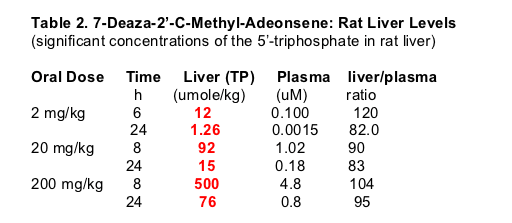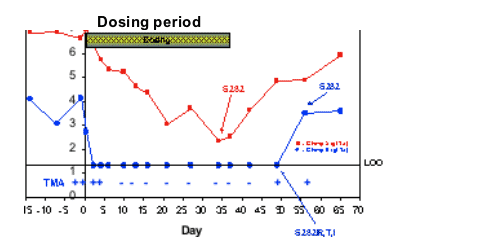 |
 |
 |
| |
The Nucleoside Inhibitor MK-0608 Mediates Suppression of HCV Replication for >30 Days in Chronically Infected Chimpanzees
|
| |
| |
Reported by Jules Levin
ICAAC, Sept 30, 2006, San Francisco
There are 3 HCV polymerase inhibitors in patient studies now: HCV-796; R1626; NM283. HCV-796 & R1626 showed 1.2 o 1.4 log viral load reductions in 10 day studies. And there are 2 HCV protease inhibitors in patients studies: VX-950, which showed 4.4 log reductions in 14 day study in viral load, and SCH503034 which showed about 1.8 logs viral load reduction in 14 day study.
David Olsen et al from Merck reported in a poster on this last day at ICAAC new study results of a study reporting the effect of a new HCV polymerase inhibitor MK-0608 in chimpanzees. The first presentation of MK-0608 was at the HIV Drug Resistance Workshop in the Summer of 2006 where a 5.7 log reduction was seen in chimps after 7 days, and with one dose three logs reduction was seen. The results reported at this ICAAC was an average reduction of 4.7 logs HCV RNA for 4 chimps who were treated. Three of 4 chimps had undetectable HCV RNA with a sensitive assay. But the baseline viral loads were lower for these 3 chimps than the chimp was saw a 5.7 log viral load reduction reported at the Resistance Workshop. Of note up til now we have seen these types of deep HCV RNA reductions only in HCV protease inhibitors.
Author Conclusions:
IV and oral dosing of MK-0608 to HCV infected chimpanzees result in significant reductions in viral load:
-- >5 log reduction in viral load (mg/kg IV)
-- no rebound during dosing
-- delay in rebound after end of extended dosing
Resistance genotype:
-- mutations at amino acid 282 detected
--reversion back to wild-type sequence dosing suggests mutant virus is debilitated relative to wild-type
ABSTRACT
Purpose: To investigate the durability and curative potential of the potent nucleoside inhibitor MK-0608 by determining if the antiviral efficacy (> 5 log) achieved in short term (7d) dosing can mediate sustained suppression and SVR with 37d of dosing.
Background: Efforts to develop direct antivirals for hepatitis C virus replication have focused largely on inhibitors of virally encoded NS3 protease and NS5B polymerase. We previously demonstrated that nucleoside analog MK-0608 (2'-C-Me-7-deaza-adenosine; replicon EC50 = 0.3 _M) when administered for 7d to infected chimpanzees achieves robust suppression of viral RNA similar in magnitude to those achieved with potent NS3 protease inhibitors.
Methods: MK-0608 was dosed QD for 37d to infected chimpanzees. Plasma viral RNA levels were quantified using the Taqman or transcription mediated amplification (TMA) assays.
Results: MK-0608 profoundly suppressed viral replication in chronically infected chimpanzees. Once daily PO dosing resulted in a rapid decrease in plasma viral RNA to below the limit of quantitation (20 IU/ml) in 3 of 4 animals in ≦10d.
Continued administration for up to 37days resulted in sustained suppression of viral load to levels below detection by the TMA assay and remained BLD throughout the dosing period.
Viral load in the fourth chimpanzee (starting titer >106 IU/mL) decreased by 4.7 logs during dosing without the selection of resistant virus.
All animals experienced a rebound in viral load upon cessation of dosing.
Conclusions: Robust antiviral efficacy was achieved with MK-0608 monotherapy in infected chimpanzees and maintained for over a month's duration without viral breakthrough. While SVR was not obtained with monotherapy for 37d, the robust and durable antiviral efficacy of MK-0608 makes it a desirable candidate for a co-dosing regimen with other antiviral agents.
Background
--Enzyme IC50 = o.o7 uM (Olsen et al 2004 Antimic Ag Chemo 48: 3944)
--Replicon EC50 (genotype 1b = 0.3uM
--Infectious gt 2a virus EC50 about 0.2 uM
--Well phosphorylated in cells
--Viral resistance is engendered by S282T mutation in the viral RNA polymerase, which results in a 30-fold loss of potency in the replicon assay.

METHODS
A total of 6 HCV-infected chimps were dosed by oral or intravenous administration. Periodically blood samples were withdrawn for compound and viral load determination using the HCV Taqman (Roche, limit of quantification - LOQ - of 20 IU.mL), or transcription mediated amplification (Roche, limit of detection 10 IU/mL) assays. Viral sequences were rescued using RT-PCR from plasma samples collected at various time points, and population cDNA sequencing of the NS5B RNA polymerase gene was carried out.
Effects on plasma viral load after IV administration at 2mg/kg in HCV-infected chimpanzee
Compound was administered at 2mg/kg once daily for 7 days. Plasma viral loads were determined using the Roche Taqman assay. The plasma concentration of the compound at about 10 minutes post-dose averaged 9.9 & 11.0 uM for chimps 3 and 4, respectively. The compound concentration at 24 hrs post each dose ranged from 80 nM after the first dose to about 200 nM after the fourth dose and did not increase thereafter. Viral loads decreased by >5 logs during dosing in both chimps (about 5.6 logs). S282 +T282 (mix) was detected after viral rebound. The two chimps in this experiment showed about a 5.5 log reduction each. Viral load rebounded after dosing stopped on day 7. The viral load decline was steep with 3 log reductions seen after 1 dose.
Effects on plasma viral load after oral administration at 1mg/kg HCV-infected genotype 1a chimpanzee
Compound was administered once daily for 37 days. Plasma viral loads were determined using the Roche Taqman assay. Qualitative detection of viral load in the chimp that LLQ was carried out using the TM assay. At the end of 37 days of dosing, plasma samples were collected 24 hrs after the last dose. The compound concentrations were determined to be 113 and 122 nM in chimps 5 and 6, respectively. Assuming that the liver:plasma ratio that was determined during dosing in the HCV-naive chimps was maintained in the HCV-infected chimps, the concentrations of 2'-C-methyl-7-deaza-adenosine (and its phospyorlated metabolites) in liver at 24 hrs after the last dose were about 6.5 and 7.1 uM in chimps 5 and 6, respectively. One chimp saw a viral load reduction of about 4.5 logs from 7 logs at baseline to about 2.5 logs at day 37 but viral load was still on a downward trend & did not reach undetectable. The initial viral load decline was not as steep as that seen for the other chimps. The 2nd chimp had a baseline viral load of just over 4 logs and reached undetectable very quickly, apparently within 1-2 days. The viral load decline was very steep.

Effects on plasma viral load after oral administration at 2mg/kg
Compound was administered once daily for 37 days. Plasma viral loads were determined using the Roche Taqman assay. Qualitative dectetion of viral load was carried out using the TMA assay. Qualitative detection of viral load was carried out using the TNA assay. Viral loads remained below LOQ in the Taqman assay for at least 6 days after dosing ended. Baseline viral load was 3.5 to 4 logs for the 2 chimps in this experiment. The chimp with 3.5 baseline viral load appeared to reach undetectable within 2-3 days and the chimp with about 3.75 logs viral load reached undetectable by about day 7-8.
|
| |
|
 |
 |
|
|